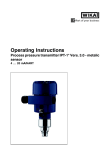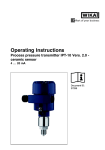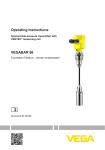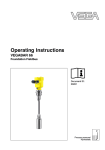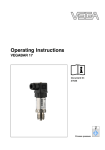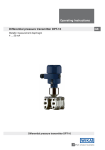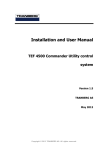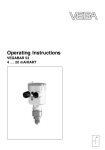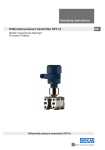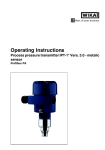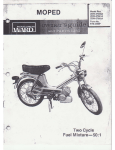Download Operating Instructions - Process pressure transmitter IPT
Transcript
Operating Instructions Process pressure transmitter IPT-1* Vers. 3.0 - metalic sensor 4 … 20 mA Document ID: 37300 Contents Contents 1 About this document 1.1 1.2 1.3 2 . . . . . . . . . .. .. .. .. .. .. .. .. .. 5 5 5 5 6 6 6 6 6 . . . . . . . . . . . . . . . . . . . . . . . . .. .. .. .. 7 8 8 9 General instructions . . . . . . . . . . . . . . . . . . . . . . . . . Mounting instructions . . . . . . . . . . . . . . . . . . . . . . . . Mounting steps. . . . . . . . . . . . . . . . . . . . . . . . . . . . . 10 12 12 Configuration . . . . . . . . . . . . . . . Principle of operation . . . . . . . . . Operation. . . . . . . . . . . . . . . . . . Packaging, transport and storage . . . . . . . . . . . . . . . . . . . . . . . . . . . . . . . . . . . . . . . . .. .. .. .. 14 15 16 17 . . . . . . . . . . . . . . . . . . .. .. .. .. .. .. 18 18 20 21 30 32 Maintenance, cleaning . . . . . . . . . . . . . . . . . . . . . . . Rectify malfunctions . . . . . . . . . . . . . . . . . . . . . . . . . Instrument repair . . . . . . . . . . . . . . . . . . . . . . . . . . . 33 33 34 Preparing the connection Connection procedure. . . Single chamber housing . Switch on phase. . . . . . . . . . . . . . . . . . . . . . . . . . . . . . . . . . . . . . . . . . . . . . . . . . . . . . . . . . . . . . . . . . . . . . . Short description . . . . . . . . . . . . . . . . . Insert indicating and adjustment module. Adjustment system . . . . . . . . . . . . . . . . Setup procedure. . . . . . . . . . . . . . . . . . Menu schematic . . . . . . . . . . . . . . . . . . Saving the parameter adjustment data . . . . . . . . . . . . . . . . . . . . . . . . . . . . . . . . Dismounting steps . . . . . . . . . . . . . . . . . . . . . . . . . . 36 Process pressure transmitter IPT-1* Vers. 3.0 - metalic sensor • 4 … 20 mA 37300-EN-100302 Dismounting 8.1 2 . . . . . . . . . Maintenance and fault rectification 7.1 7.2 7.3 8 . . . . . . . . . Set up with the indicating and adjustment module 6.1 6.2 6.3 6.4 6.5 6.6 7 . . . . . . . . . Connecting to power supply 5.1 5.2 5.3 5.4 6 . . . . . . . . . Mounting 4.1 4.2 4.3 5 . . . . . . . . . Authorised personnel . . . . . . . . . . . . . . . . Appropriate use . . . . . . . . . . . . . . . . . . . . Warning about misuse . . . . . . . . . . . . . . . General safety instructions . . . . . . . . . . . . Safety label on the instrument . . . . . . . . . . CE conformity . . . . . . . . . . . . . . . . . . . . . Fulfillment of NAMUR recommendations . . Safety instructions for Ex areas . . . . . . . . . Safety instructions for oxygen applications . Product description 3.1 3.2 3.3 3.4 4 4 4 4 For your safety 2.1 2.2 2.3 2.4 2.5 2.6 2.7 2.8 2.9 3 Function. . . . . . . . . . . . . . . . . . . . . . . . . . . . . . . . . . Target group . . . . . . . . . . . . . . . . . . . . . . . . . . . . . . Symbolism used. . . . . . . . . . . . . . . . . . . . . . . . . . . . Contents 8.2 9 Removal . . . . . . . . . . . . . . . . . . . . . . . . . . . . . . . . . 36 Supplement 9.1 9.2 Technical data . . . . . . . . . . . . . . . . . . . . . . . . . . . . . Dimensions . . . . . . . . . . . . . . . . . . . . . . . . . . . . . . . 37 44 Supplementary documentation Information: Supplementary documents appropriate to the ordered version come with the delivery. You can find them listed in chapter "Product description". 37300-EN-100302 Instructions manuals for accessories and replacement parts Tip: To ensure reliable setup and operation of your IPT-1*, we offer accessories and replacement parts. The corresponding documentations are: l Operating instructions manual "External indicating and adjustment unit" Process pressure transmitter IPT-1* Vers. 3.0 - metalic sensor • 4 … 20 mA 3 1 About this document 1 About this document 1.1 Function This operating instructions manual provides all the information you need for mounting, connection and setup as well as important instructions for maintenance and fault rectification. Please read this information before putting the instrument into operation and keep this manual accessible in the immediate vicinity of the device. 1.2 Target group This operating instructions manual is directed to trained qualified personnel. The contents of this manual should be made available to these personnel and put into practice by them. 1.3 Symbolism used Information, tip, note This symbol indicates helpful additional information. Caution: If this warning is ignored, faults or malfunctions can result. Warning: If this warning is ignored, injury to persons and/or serious damage to the instrument can result. Danger: If this warning is ignored, serious injury to persons and/or destruction of the instrument can result. Ex applications This symbol indicates special instructions for Ex applications. l à 1 List The dot set in front indicates a list with no implied sequence. Action This arrow indicates a single action. Sequence Numbers set in front indicate successive steps in a procedure. 37300-EN-100302 4 Process pressure transmitter IPT-1* Vers. 3.0 - metalic sensor • 4 … 20 mA 2 For your safety 2 For your safety 2.1 Authorised personnel Mount and set up the pressure transmitter only if you know the applicable national regulations and have the appropriate qualification. You must be aquainted with the regulations and instructions for hazardous areas, measurement and control technology as well as electrical circuits because the pressure transmitter is "electrical equipment" according to EN 50178. Depending on the application conditions, it is necessary that you have appropriate knowledge, e.g. concerning corrosive products or high pressure. 2.2 Appropriate use IPT-1* is a pressure transmitter for measurement of gauge pressure, absolute pressure and vacuum. You can find detailed information on the application range in chapter "Product description". Operational reliability is ensured only if the instrument is properly used according to the specifications in the operating instructions manual as well as possible supplementary instructions. For safety and warranty reasons, any invasive work on the device beyond that described in the operating instructions manual may be carried out only by personnel authorised by the manufacturer. Arbitrary conversions or modifications are explicitly forbidden. 2.3 Warning about misuse Inappropriate or incorrect use of the instrument can give rise to application-specific hazards, e.g. vessel overfill or damage to system components through incorrect mounting or adjustment. 2.4 General safety instructions This is a high-tech instrument requiring the strict observance of standard regulations and guidelines. The user must take note of the safety instructions in this operating instructions manual, the countryspecific installation standards as well as all prevailing safety regulations and accident prevention rules. 37300-EN-100302 The instrument must only be operated in a technically flawless and reliable condition. The operator is responsible for trouble-free operation of the instrument. During the entire duration of use, the user is obliged to determine the compliance of the required occupational safety measures with the current valid rules and regulations and also take note of new regulations. Process pressure transmitter IPT-1* Vers. 3.0 - metalic sensor • 4 … 20 mA 5 2 For your safety 2.5 Safety label on the instrument The safety approval markings and safety tips on the device must be observed. 2.6 CE conformity This device fulfills the legal requirements of the applicable EC guidelines. By attaching the CE mark, we provide confirmation of successful testing. 2.7 Fulfillment of NAMUR recommendations The device fulfills the requirements of the applicable NAMUR recommendations. 2.8 Safety instructions for Ex areas Please note the Ex-specific safety information for installation and operation in Ex areas. These safety instructions are part of the operating instructions manual and come with the Ex-approved instruments. 2.9 Safety instructions for oxygen applications For instruments in oxygen applications the special instructions in chapters "Storage and transport", "Mounting" as well as "Technical data" under "Process conditions"must be noted. Furthermore the valid national regulations, implementation instructions and memorandums of the BG (professional assoc.) must be noted. 37300-EN-100302 6 Process pressure transmitter IPT-1* Vers. 3.0 - metalic sensor • 4 … 20 mA 3 Product description 3 Product description 3.1 Configuration Scope of delivery The scope of delivery encompasses: l l IPT-1* process pressure transmitter Documentation - this operating instructions manual - Test certificate for pressure transmitters - Operating instructions manual "Indicating and adjustment module" (optional) - Supplementary instructions manual "Plug connector for continuously measuring sensors" (optional) - Ex-specific "Safety instructions" (with Ex versions) - if necessary, further certificates Supplementary label "Oil and grease-free for oxygen applications" Instruments in the version "Oil and grease-free for oxygen applications" are equipped with a supplementary label. The supplementary label contains instructions on oil and grease-free parts of the instrument. Constituents The IPT-1* consist of the following components: l l l Process fitting with measuring cell Housing with electronics, optionally available with plug connector Housing cover, optionally available with indicating and adjustment module The components are available in different versions. 1 2 3 37300-EN-100302 Fig. 1: Example of a IPT-1* with manometer connection G½ according to EN 837 and Alu housing 1 2 3 Type label Housing cover with integrated indicating and adjustment module (optional) Housing with electronics Process fitting with measuring cell The type label contains the most important data for identification and use of the instrument: Process pressure transmitter IPT-1* Vers. 3.0 - metalic sensor • 4 … 20 mA 7 3 Product description l l l l l l Instrument type Article and serial number device Technical data: Measuring range, process pressure, process temperature, signal output, voltage supply, protection, protection class Order number Article number, documentation SIL identification (with SIL rating ex works) 3.2 Principle of operation Application area IPT-1* is a pressure transmitter for measurement of overpressure, absolute pressure or vacuum. Measured products are gases, vapours and liquids in measuring ranges up to 4000 bar (400 MPa); with frontflush version also viscous liquids in measuring ranges up to 600 bar (60 MPa). Functional principle The process pressure acts on the sensor element via the stainless steel diaphragm. The process pressure causes a resistance change which is converted into a corresponding output signal and outputted as measured value.1) Voltage supply Two-wire electronics 4 … 20 mA for power supply and measured value transmission over the same cable. The supply voltage range can differ depending on the instrument version. The exact range is stated in chapter "Technical data". The background lighting of the indicating and adjustment module is powered by the sensor. A certain level of operating voltage is required for this. You can find the exact voltage specifications in chapter "Technical data". 3.3 Operation IPT-1* can be adjusted with different adjustment media: l l l l with indicating and adjustment module the suitable WIKA DTM in conjunction with an adjustment software according to the FDT/DTM standard, e.g. PACTware and PC with manufacturer-specific adjustment programs AMS™ or PDM With a HART handheld The entered parameters are generally saved in IPT-1*, optionally also in the indicating and adjustment module or in PACTware. 8 Measuring ranges up to 16 bar: piezoresistive sensor element with internal transmission liquid. Measuring ranges up to 25 bar: strain gauge (DMS) sensor element on the rear of the stainless steel diaphragm (dry). Process pressure transmitter IPT-1* Vers. 3.0 - metalic sensor • 4 … 20 mA 37300-EN-100302 1) 3 Product description 3.4 Packaging, transport and storage Packaging Your instrument was protected by packaging during transport. Its capacity to handle normal loads during transport is assured by a test according to DIN EN 24180. The packaging of standard instruments consists of environmentfriendly, recyclable cardboard. For special versions, PE foam or PE foil is also used. Dispose of the packaging material via specialised recycling companies. Caution: Instruments for oxygen applications are sealed in PE foil and provided with a label "Oxygen! Use no Oil". Remove this foil just before mounting the instrument! See instruction under "Mounting". Transport Transport must be carried out under consideration of the notes on the transport packaging. Nonobservance of these instructions can cause damage to the device. Transport inspection The delivery must be checked for completeness and possible transit damage immediately at receipt. Ascertained transit damage or concealed defects must be appropriately dealt with. Storage Up to the time of installation, the packages must be left closed and stored according to the orientation and storage markings on the outside. Unless otherwise indicated, the packages must be stored only under the following conditions: Storage and transport temperature l l l l l Not in the open Dry and dust free Not exposed to corrosive media Protected against solar radiation Avoiding mechanical shock and vibration l Storage and transport temperature see chapter "Supplement Technical data - Ambient conditions" Relative humidity 20 … 85 % 37300-EN-100302 l Process pressure transmitter IPT-1* Vers. 3.0 - metalic sensor • 4 … 20 mA 9 4 Mounting 4 Mounting 4.1 General instructions Suitability for the process conditions Make sure that all parts of the instrument exposed to the process, in particular the sensor element, process seal and process fitting, are suitable for the existing process conditions. These include above all the process pressure, process temperature as well as the chemical properties of the medium. You can find the specifications in chapter "Technical data" or on the type label. Diaphragm protection To protect the diaphragm, the process fitting is covered by a protective cap. Remove the protective cap just before installation so that the diaphragm will not get damaged. It is recommended to keep the cap and use it again later for storage or transport. Mounting position Select an installation position you can easily reach for mounting and connecting as well as later retrofitting of an indicating and adjustment module. The housing can be rotated by 330° without the use of any tools. You can also install the indicating and adjustment module in four different positions (each displaced by 90°). Moisture Use the recommended cables (see chapter "Connecting to power supply") and tighten the cable gland. You can give your instrument additional protection against moisture penetration by leading the connection cable downward in front of the cable entry. Rain and condensation water can thus drain off. This applies mainly to outdoor mounting as well as installation in areas where high humidity is expected (e.g. through cleaning processes) or on cooled or heated vessels. 37300-EN-100302 10 Process pressure transmitter IPT-1* Vers. 3.0 - metalic sensor • 4 … 20 mA 4 Mounting Fig. 2: Measures against moisture penetration Ventilation The ventilation for the electronics housing is realised via a filter element in the vicinity of the cable glands. Fig. 3: Position of the filter element with single and double chamber housing 1 2 Filter element for ventilation of the electronics housing Blind stopper Information: Make sure that the filter element is always free of buildup during operation. A high-pressure cleaner must not be used for cleaning. Higher process temperatures mean often also higher ambient temperatures. 37300-EN-100302 Temperature limits Process pressure transmitter IPT-1* Vers. 3.0 - metalic sensor • 4 … 20 mA 11 4 Mounting 2 1 Fig. 4: Temperature ranges 1 2 Process temperature Ambient temperature Make sure that the upper temperature limits for the environment of electronics housing and connection cable specified in chapter "Technical data" are not exceeded. Oxygen applications Instruments in the version "Oil and grease free for oxygen" should be unpacked just before mounting. After the protective cover of the process fitting has been removed, the label "O₂" on the process fitting is visible. Danger: Avoid oil, grease or contamination. Explosion danger! 4.2 Mounting instructions Mounting position IPT-1* functions in any installation position. It is mounted according to the same directives as a manometer (DIN EN 839-2).2) Information: We recommend using lock fittings, measuring instrument holders and siphons from the line of WIKA accessories. 4.3 Mounting steps Welding the socket à Note the applicable welding standards (segment welding procedure) when welding the socket. 2) 12 Probable position correction see chapter "Setup steps". Process pressure transmitter IPT-1* Vers. 3.0 - metalic sensor • 4 … 20 mA 37300-EN-100302 To mount IPT-1*, a welded socket is necessary. Use components from the line of WIKA mounting accessories. 4 Mounting Sealing/Screwing in Use the seal corresponding to the instrument: l Process fitting GD: Tesnit seal in front of the thread - or Seal the thread with teflon, hemp or a similar resistant seal material: l Process fitting GN à Screw IPT-1* into the welded socket. Tighten the hexagon on the process fitting with a suitable wrench. Wrench size, see chapter "Dimensional drawings". Warning: The housing must not be used to screw the instrument in! Applying tightening force can damage internal parts of the housing. Use the seal suitable for the respective process fitting. You can find the components in the supplementary instructions manual "Welded socket and seals". 37300-EN-100302 Sealing/Screwing in hygienic fittings Process pressure transmitter IPT-1* Vers. 3.0 - metalic sensor • 4 … 20 mA 13 5 Connecting to power supply 5 Connecting to power supply 5.1 Preparing the connection Note safety instructions Always keep in mind the following safety instructions: l l Connect only in the complete absence of line voltage If overvoltage surges are expected, overvoltage arresters should be installed Take note of safety instructions for Ex applications In hazardous areas you should take note of the appropriate regulations, conformity and type approval certificates of the sensors and power supply units. Select power supply Power supply and current signal are transmitted via the same two-wire connection cable. The supply voltage range can differ depending on the instrument version. The exact range is stated in the "Technical data" in the "Supplement". Provide a reliable separation between the supply circuit and the mains circuits according to DIN VDE 0106 part 101. Keep in mind the following additional influences on the operating voltage: l l Selecting connection cable Output voltage of the power supply unit can be lower under nominal load (with a sensor current of 20.5 mA or 22 mA in case of fault message) Influence of additional instruments in the circuit (see load values in chapter "Technical data") The instrument is connected with standard two-wire cable without screen. If electromagnetic interference is expected which is above the test values of EN 61326 for industrial areas, screened cable should be used. Use cable with round cross-section. A cable outer diameter of 5 … 9 mm (0.2 … 0.35 in) ensures the seal effect of the cable gland. If you are using cable with a different diameter or cross-section, exchange the seal or use a suitable cable gland. Cable screening and grounding If screened cable is necessary, connect the cable screen on both ends to ground potential. In the sensor, the screen must be connected directly to the internal ground terminal. The ground terminal on the outside of the housing must be connected to the potential equalisation (low impedance). 14 Process pressure transmitter IPT-1* Vers. 3.0 - metalic sensor • 4 … 20 mA 37300-EN-100302 If potential equalisation currents are expected, the connection on the processing side must be made via a ceramic capacitor (e. g. 1 nF, 1500 V). The low frequency potential equalisation currents are thus suppressed, but the protective effect against high frequency interference signals remains. 5 Connecting to power supply Select connection cable for Ex applications Take note of the corresponding installation regulations for Ex applications. In particular, make sure that no potential equalisation currents flow over the cable screen. In case of grounding on both sides this can be achieved by the use of a capacitor or a separate potential equalisation. 5.2 Connection procedure 37300-EN-100302 Proceed as follows: 1 Unscrew the housing cover 2 If an indicating and adjustment module is installed, remove it by turning it slightly to the left. 3 Loosen compression nut of the cable entry 4 Remove approx. 10 cm (4 in) of the cable mantle, strip approx. 1 cm (0.4 in) of insulation from the ends of the individual wires 5 Insert the cable through the cable gland into the sensor 6 Lift the opening levers of the terminals with a screwdriver (see following illustration) 7 Insert the wire ends into the open terminals according to the wiring plan Fig. 5: Connection steps 6 and 7 8 Press down the opening levers of the terminals, you will hear the terminal spring closing Process pressure transmitter IPT-1* Vers. 3.0 - metalic sensor • 4 … 20 mA 15 5 Connecting to power supply 9 Check the hold of the wires in the terminals by lightly pulling on them 10 Connect the screen to the internal ground terminal, connect the outer ground terminal with potential equalisation 11 Tighten the compression nut of the cable entry. The seal ring must completely encircle the cable 12 Screw the housing cover on The electrical connection is finished. 5.3 Single chamber housing Electronics and connection compartment 4...20mA 1 1 Display 2 2 Fig. 6: Electronics and connection compartment with single chamber housing 1 2 Spring-loaded terminals for voltage supply Ground terminal for connection of the cable screen 37300-EN-100302 16 Process pressure transmitter IPT-1* Vers. 3.0 - metalic sensor • 4 … 20 mA 5 Connecting to power supply Wiring plan 4...20mA 1 Display 2 1 Fig. 7: Wiring plan, single chamber housing 1 Voltage supply/Signal output 5.4 Switch on phase Switch on phase After connecting IPT-1* to power supply or after a voltage recurrence, the instrument carries out a self-check for approx. 30 seconds: l l l Internal check of the electronics Indication of the instrument type, the firmware as well as the sensor TAGs (sensor designation) Output signal jumps briefly (approx. 10 seconds) to the set fault current 37300-EN-100302 Then the corresponding current is outputted to the cable (the value corresponds to the actual level as well as the settings already carried out, e.g. factory setting). Process pressure transmitter IPT-1* Vers. 3.0 - metalic sensor • 4 … 20 mA 17 6 Set up with the indicating and adjustment module 6 Set up with the indicating and adjustment module 6.1 Short description Function/Configuration The indicating and adjustment module is used for measured value display, adjustment and diagnosis. It can be mounted in the following housing versions and instruments: l l All sensors of the IPT-1* instrument family, in the single as well as double chamber housing (optionally in the electronics or connection compartment) External indicating and adjustment unit Note: You can find detailed information on adjustment in the operating instructions manual "Indicating and adjustment module". 6.2 Insert indicating and adjustment module Mount/Dismount indicating and adjustment module The indicating and adjustment module can be inserted and removed at any time. It is not necessary to interrupt the voltage supply. For installation, proceed as follows: 1 Unscrew the housing cover 2 Place the indicating and adjustment module in the desired position on the electronics (you can choose any one of four different positions - each displaced by 90°) 3 Press the indicating and adjustment module onto the electronics and turn it to the right until it snaps in. 4 Screw housing cover with inspection window tightly back on Removal is carried out in reverse order. The indicating and adjustment module is powered by the sensor, an additional connection is not necessary. 37300-EN-100302 18 Process pressure transmitter IPT-1* Vers. 3.0 - metalic sensor • 4 … 20 mA 6 Set up with the indicating and adjustment module Fig. 8: Insert indicating and adjustment module 37300-EN-100302 Note: If you intend to retrofit the instrument with an indicating and adjustment module for continuous measured value indication, a higher cover with an inspection glass is required. Process pressure transmitter IPT-1* Vers. 3.0 - metalic sensor • 4 … 20 mA 19 6 Set up with the indicating and adjustment module 6.3 Adjustment system 2 1 1.1 3 Fig. 9: Indicating and adjustment elements Key functions Adjustment system 1 2 3 LC display Indication of the menu item number Adjustment keys l [OK] key: - Move to the menu overview - Confirm selected menu - Edit parameter - Save value l [->] key to select: - Menu change - Select list entry - Select editing position l [+] key: - Change value of the parameter l [ESC] key: - interrupt input - jump to the next higher menu The sensor is adjusted via the four keys of the indicating and adjustment module. The LC display indicates the individual menu items. The functions of the individual keys are shown in the above illustration. Approx. 10 minutes after the last pressing of a key, an automatic reset to measured value indication is triggered. Any values not confirmed with [OK] will not be saved. 37300-EN-100302 20 Process pressure transmitter IPT-1* Vers. 3.0 - metalic sensor • 4 … 20 mA 6 Set up with the indicating and adjustment module 6.4 Setup procedure Level or process pressure measurement IPT-1* can be used for level as well as for process pressure measurement. Default setting is level measurement. The mode can be changed in the adjustment menu. Depending on the application only the respective subchapter "Level or process pressure measurement" is of importance. There, you find the individual adjustment steps. Level measurement Parameter adjustment "Level measurement" Set up IPT-1* in the following sequence: 1 Selecting adjustment unit/density unit 2 Carry out position correction 3 Carrying out min. adjustment 4 Carrying out max. adjustment In the menu item "Adjustment unit" you select the physical unit in which the adjustment should be carried out, e.g. mbar, bar, psi… The position correction compensates the influence of the mounting position or static pressure on the measurement. It does not influence the adjustment values. Information: The steps 1, 3 and 4 are not necessary for instruments which are already preset according to customer specifications! You can find the data on the type label on the instrument or in the menu items of the min./max. adjustment. The indicating and adjustment module enables the adjustmetn without filling or pressure. Thanks to this, you can carry out your settings already in the factory without the instrument having to be installed. The actual measured value is also displayed in the menu items for min./max. adjustment. Select unit In this menu item you select the adjustment unit as well as the unit for the temperature indication in the display. 37300-EN-100302 To select the adjustment unit (in the example switching over from bar to mbar), proceed as follows:3) 1 Push the [OK] button in the measured value display, the menu overview is displayed. 3) Selection options: mbar, bar, psi, Pa, kPa, MPa, inHg, mmHg, inH2O, mmH2O. Process pressure transmitter IPT-1* Vers. 3.0 - metalic sensor • 4 … 20 mA 21 6 Set up with the indicating and adjustment module ▶ 2 Basic adjustment Display Diagnostics Service Info Confirm the menu "Basic adjustment" with [OK], the menu item "Unit" will be displayed. Unit Unit of measurement bar▼ Temperature unit °C▼ 3 Activate the selection with [OK] and select "Units of measurement with [->]. 4 Activate the selection with [OK] and select the requested unit with [->] (in the example mbar). 5 Confirm with [OK] and move to position correction with [->]. The adjustment unit is thus switched over from bar to mbar. Information: When switching over to adjustment in a height unit (in the example from bar to m), the density also has to be entered. Proceed as follows: 1 Push the [OK] button in the measured value display, the menu overview is displayed. 2 Confirm the menu "Basic adjustment" with [OK], the menu item "Units of measurement" will be displayed. 3 Activate the selection with [OK] and select the requested unit with [->] (in the example m). 4 Confirm with [OK], the submenu "Density unit" appears. Unit of measurement ▶ 5 Density unit kg/dm³ pcf Select the requested unit, e.g. kg/dm³ with [->] and confirm with [OK], the submenu "Density" appears. Unit of measurement 6 22 Enter the requested density value with [->] and [+], confirm with [OK] and move to position correction with [->]. Process pressure transmitter IPT-1* Vers. 3.0 - metalic sensor • 4 … 20 mA 37300-EN-100302 Density 0001000 kg/dm³ 6 Set up with the indicating and adjustment module The adjustment unit is thus switched over from bar to m. Proceed as follows to select the temperature unit:4) à Activate the selection with [OK] and select "Temperature unit with [->]. à Activate the selection with [OK] and select the requested unit with [->] (e.g. °F). à Confirm with [OK]. The temperature unit is hence switched over from °C to °F. Carry out position correction Proceed as follows: 1 Activate in the menu item "Position correction" the selection with [OK]. Position correction Offset = +0000 mbar 53 mbar 2 ▶ 3 Carrying out min. adjustment P Select with [->], e.g. to accept actual measured value. Position correction Accept current measured value? Accept Edit Confirm with [OK] and move to min.(zero) adjustment with [->]. Proceed as follows: 1 Edit the % value in the menu item "Min. adjustment" with [OK]. Min. adjustment +000.0 % = +0000.0 mbar 0000.0 mbar 2 Set the requested percentage value with [+] and [->]. 3 Edit the requested mbar value with [OK]. 4 Set the requested mbar value with [+] and [->]. 5 Confirm with [+] and move to max. adjustment with [->]. 37300-EN-100302 The min. adjustment is finished. Information: For an adjustment with filling, simply enter the actual measured value indicated at the bottom of the display. 4) Selection options: °C, °F. Process pressure transmitter IPT-1* Vers. 3.0 - metalic sensor • 4 … 20 mA 23 6 Set up with the indicating and adjustment module If the adjustment ranges are exceeded, the message "Outside parameter limits" appears. The editing procedure can be aborted with [ESC] or the displayed limit value can be accepted with [OK]. Carrying out max. adjustment Proceed as follows: 1 Edit the % value in the menu item "Max. adjustment" with [OK]. Max. adjustment +100.0 % = +1000.0 mbar 0000.0 mbar Information: The displayed pressure for 100 % corresponds to the nominal measuring range of the sensor (in the above example 1 bar = 1000 mbar). 2 Set the requested percentage value with [->] and [OK]. 3 Edit the requested mbar value with [OK]. 4 Set the requested mbar value with [+] and [->]. 5 Confirm with [OK] and move to the menu overview with [ESC]. The max. adjustment is finished. Information: For an adjustment with filling, simply enter the actual measured value indicated at the bottom of the display. If the adjustment ranges are exceeded, the message "Outside parameter limits" appears. The editing procedure can be aborted with [ESC] or the displayed limit value can be accepted with [OK]. Process pressure measurement Parameter adjustment "Process pressure measurement" Set up IPT-1* in the following sequence: 1 Select application "Process pressure measurement" 2 Select the unit of measurement 3 Carry out position correction 4 Carrying out zero adjustment 5 Carrying out span adjustment In the menu item "Adjustment unit" you select the physical unit in which the adjustment should be carried out, e.g. mbar, bar, psi… 24 Process pressure transmitter IPT-1* Vers. 3.0 - metalic sensor • 4 … 20 mA 37300-EN-100302 The position correction compensates the influence of the mounting position or static pressure on the measurement. It does not influence the adjustment values. 6 Set up with the indicating and adjustment module In the menu items "zero" and "span" you determine the span of the sensor, the span corresponds to the end value. Information: The steps 1, 3 and 4 are not necessary for instruments which are already preset according to customer specifications! You can find the data on the type label on the instrument or in the menu items of the zero/span adjustment. The indicating and adjustment module enables the adjustmetn without filling or pressure. Thanks to this, you can carry out your settings already in the factory without the instrument having to be installed. The actual measured value is displayed in addition to the menu items for zero/span adjustment. Select application "Process pressure measurement" IPT-1* is preset to application "Level measurement". Proceed as follows when switching over to application "Process pressure measurement": 1 2 ▶ 3 Push the [OK] button in the measured value display, the menu overview is displayed. Select the menu "Service" with [->] and confirm with [OK]. Basic adjustment Display Diagnostics Service Info Select the menu item "Application" with [->] and edit with [OK]. Warning: Note the warning: "Output can change". Select unit 4 Select with [->] "OK" and confirm with [OK]. 5 Select "Process pressure" from the list and confirm with [OK]. In this menu item you select the adjustment unit as well as the unit for the temperature indication in the display. 37300-EN-100302 To select the adjustment unit (in the example switching over from bar to mbar), proceed as follows:5) 1 Push the [OK] button in the measured value display, the menu overview is displayed. 5) Selection options: mbar, bar, psi, Pa, kPa, MPa, inHg, mmHg, inH2O, mmH2O. Process pressure transmitter IPT-1* Vers. 3.0 - metalic sensor • 4 … 20 mA 25 6 Set up with the indicating and adjustment module ▶ 2 Basic adjustment Display Diagnostics Service Info Confirm the menu "Basic adjustment" with [OK], the menu item "Unit" will be displayed. Unit Unit of measurement bar▼ Temperature unit °C▼ 3 Activate the selection with [OK] and select "Units of measurement with [->]. 4 Activate the selection with [OK] and select the requested unit with [->] (in the example mbar). 5 Confirm with [OK] and move to position correction with [->]. The adjustment unit is thus switched over from bar to mbar. Proceed as follows to select the temperature unit:6) à Activate the selection with [OK] and select "Temperature unit with [->]. à Activate the selection with [OK] and select the requested unit with [->] (e.g. °F). à Confirm with [OK]. The temperature unit is hence switched over from °C to °F. Carry out position correction Proceed as follows: 1 Activate in the menu item "Position correction" the selection with [OK]. Position correction Offset = +0000 mbar 53 mbar 2 ▶ Select with [->], e.g. to accept actual measured value. Position correction Accept current measured value? Accept Edit 3 Confirm with [OK] and move to min.(zero) adjustment with [->]. 6) Selection options: °C, °F. Process pressure transmitter IPT-1* Vers. 3.0 - metalic sensor • 4 … 20 mA 37300-EN-100302 26 P 6 Set up with the indicating and adjustment module Carrying out zero adjustment Proceed as follows: 1 Edit the mbar value in the menu item "zero" with [OK]. Zero 000.0 % = +0000.0 mbar 0000.0 mbar P 2 Set the requested mbar value with [+] and [->]. 3 Confirm with [+] and move to span adjustment with [->]. The zero adjustment is finished. Information: The zero adjustment shifts the value of the span adjustment. The span, i.e. the difference between these values, however, remains unchanged. Information: For an adjustment with pressure, simply enter the actual measured value indicated at the bottom of the display. If the adjustment ranges are exceeded, the message "Outside parameter limits" appears. The editing procedure can be aborted with [ESC] or the displayed limit value can be accepted with [OK]. Carrying out span adjustment Proceed as follows: 1 Edit the mbar value in the menu item "span" with [OK]. Span 100.0 % = +1000.0 mbar 0000.0 mbar P Information: The displayed pressure for 100 % corresponds to the nominal measuring range of the sensor (in the above example 1 bar = 1000 mbar). 2 Set the requested mbar value with [->] and [OK]. 3 Confirm with [OK] and move to the menu overview with [ESC]. 37300-EN-100302 The span adjustment is finished. Information: For an adjustment with pressure, simply enter the actual measured value indicated at the bottom of the display. Process pressure transmitter IPT-1* Vers. 3.0 - metalic sensor • 4 … 20 mA 27 6 Set up with the indicating and adjustment module If the adjustment ranges are exceeded, the message "Outside parameter limits" appears. The editing procedure can be aborted with [ESC] or the displayed limit value can be accepted with [OK]. Copy sensor data This function enables reading out parameter adjustment data as well as writing parameter adjustment data into the sensor via the indicating and adjustment module. A description of the function is available in the operating instructions manual "Indicating and adjustment module". The following data are read out or written with this function: l l l l l l l l l l l Measured value presentation Adjustment Damping Linearisation curve Sensor-TAG Displayed value Display unit Scaling Current output Unit of measurement Language The following safety-relevant data are not read out or written: l l l l SIL HART mode PIN Application Copy sensor data Copy sensor data? Reset Menu section Basic settings Function Reset value Unit of measurement bar Temperature unit °C Zero/Min. adjustment Measuring range begin Span/Max. adjustment Measuring range end Density 1 kg/l Density unit kg/l Damping 1s Linearisation linear Process pressure transmitter IPT-1* Vers. 3.0 - metalic sensor • 4 … 20 mA 37300-EN-100302 28 Basic adjustment If the "Reset" (sensor-specific basic adjustment) is carried out, the sensor resets the values of the following menu items to the reset values (see chart): 6 Set up with the indicating and adjustment module Menu section Display Service Function Reset value Sensor-TAG Sensor Displayed value 1 bar Displayed value 2 % Display unit Volume/l Scaling 0.00 to 100.0 Decimal point indication 8888.8 Current output - characteristics 4 … 20 mA Current output - failure < 3.6 mA Current output - min. current 3.8 mA Current output - max. current 20.5 mA The values of the following menu items are not reset with "Reset: Menu section Function Reset value Basic settings Position correction no reset Display Lighting no reset Service SIL no reset Language no reset HART mode no reset Application no reset Factory setting Like basic adjustment, in addition, special parameters are reset to default values.7) Pointer The min. and max. temperature or pressure values are each reset to the actual value. 37300-EN-100302 Optional settings Additional adjustment and diagnosis options such as e.g. scaling, simulation or trend curve presentation are shown in the following menu schematic. You will find a detailed description of these menu items in the operating instructions manual "Indicating and adjustment module". 7) Special parameters are parameters which are set customer-specifically on the service level with the adjustment software PACTware. Process pressure transmitter IPT-1* Vers. 3.0 - metalic sensor • 4 … 20 mA 29 6 Set up with the indicating and adjustment module 6.5 Menu schematic Information: Depending on the version and application, the highlighted menu windows may not always be available. Basic adjustment ▶ Basic adjustment Display Diagnostics Service Info 1 Unit Unit of measurement bar▼ Temperature unit °C▼ 1.1 Damping 1.5 Position correction Offset = 0.2 mbar 0000 mbar 1.2 Linearisation curve 1.6 P linear ▼ 1s Min. adjustment 000.0 % = 0.0 mbar 0.0 mbar 1.3 Sensor-TAG 1.7 Max. adjustment 100.00 % = 100.00 mbar 0.0 mbar 1.4 Scaling 0 % = 0.0 l 100 % = 100.0 l 2.3 Sensor Display ▶ Basic adjustment Display Diagnostics Service Info Displayed value 2 2.1 Pressure ▼ Lighting Displayed value ▼ Scaled 2.1 Display unit Volume ▼ l▼ 2.2 2.4 Switched off ▼ 37300-EN-100302 30 Process pressure transmitter IPT-1* Vers. 3.0 - metalic sensor • 4 … 20 mA 6 Set up with the indicating and adjustment module Diagnostics ▶ Basic adjustment Display Diagnostics Service Info Pointer p-min.: -5.8 mbar p-max.: 167.5 mbar T-min.: -12.5 °C T-max.: +85.5 °C 3 3.1 Sensor status 3.2 OK Trend curve 3.3.1 Start trend curve? Service ▶ Basic adjustment Display Diagnostics Service Info Current output 4 4.1 Output mode: 4-20 mA ▼ Fail.mode: < 3.6 mA ▼ Min. current: 3.8 mA ▼ max. current: 20.5 mA ▼ Copy sensor data Simulation 4.2 Start simulation ▼ 4.7 Copy sensor data? 4.3 Select reset ▼ 4.8 PIN Reset Application Language 4.4 Deutsch ▼ 4.9 Level ▼ Enable? Info ▶ Basic adjustment Display Diagnostics Service Info Instrument type 5.1 Date of manufacture 1st October 2009 Software version 3.80 5.2 Last change using PC 5.3 Sensor characteristics 5.4 Display now? 1st October 2009 37300-EN-100302 Serial number 12345678 5 Process pressure transmitter IPT-1* Vers. 3.0 - metalic sensor • 4 … 20 mA 31 6 Set up with the indicating and adjustment module 6.6 Saving the parameter adjustment data It is recommended noting the adjusted data, e.g. in this operating instructions manual and archive them afterwards. They are hence available for multiple use or service purposes. If IPT-1* is equipped with an indicating and adjustment module, the most important data can be read out of the sensor into indicating and adjustment module. The procedure is described in the operating instructions manual "Indicating and adjustment module" in the menu item "Copy sensor data". The data remain there permanently even if the sensor power supply fails. If it is necessary to exchange the sensor, the indicating and adjustment module is inserted into the replacement instrument and the data are written into the sensor under the menu item "Copy sensor data". 37300-EN-100302 32 Process pressure transmitter IPT-1* Vers. 3.0 - metalic sensor • 4 … 20 mA 7 Maintenance and fault rectification 7 Maintenance and fault rectification 7.1 Maintenance, cleaning When the instrument is used properly, no special maintenance is required in normal operation. In some applications, product buildup on the sensor diaphragm can influence the measuring result. Depending on the sensor and application, take precautions to ensure that heavy buildup, and especially a hardening thereof, is avoided. If necessary, the transmitter has to be cleaned. In this case, make sure that the materials are resistant against the cleaning detergents. 7.2 Rectify malfunctions Reaction when malfunctions occur The operator of the system is responsible for taking suitable measures to remove interferences. Causes of malfunction IPT-1* offers maximum reliability. Nevertheless, faults can occur during operation. These may be caused by the following, e.g.: l l l l Sensor Process Voltage supply Signal processing Fault rectification The first measures to be taken are to check the output signals as well as to evaluate the error messages via the indicating and adjustment module. The procedure is described below. Further comprehensive diagnostics can be carried out on a PC with the software PACTware and the suitable DTM. In many cases, the causes can be determined this way and faults rectified. Checking the 4 … 20 mA signal Connect a handheld multimeter in the suitable measuring range according to the wiring plan. ? 4 … 20 mA signal not stable l Level fluctuations à Set the integration time via the indicating and adjustment module or PACTware 37300-EN-100302 l no atmospheric pressure compensation à Check the pressure compensation in the housing and clean the filter element, if necessary Process pressure transmitter IPT-1* Vers. 3.0 - metalic sensor • 4 … 20 mA 33 7 Maintenance and fault rectification ? 4 … 20 mA signal missing l Connection to voltage supply wrong à Check connection according to chapter "Connection steps" and if necessary, correct according to chapter "Wiring plan" l No power supply à Check cables for breaks; repair if necessary l Operating voltage too low or load resistance too high à Check, adapt if necessary ? Current signal greater than 22 mA or less than 3.6 mA l electronics module or measuring cell defective à Exchange the instrument or send it for repair In Ex applications, the regulations for the wiring of intrinsically safe circuits must be observed. Fault messages via the indicating/adjustment module ? E013 l no measured value available8) à Exchange the instrument or send it for repair ? E017 l Adjustment span too small à repeat with modified values ? E036 l no operable sensor software à Carry out a software update or send instrument for repair ? E041 l Hardware error à Exchange the instrument or send it for repair Reaction after fault rectification Depending on the failure reason and measures taken, the steps described in chapter "Set up" must be carried out again, if necessary. 7.3 Instrument repair You can download a return form (24 KB) in the Internet from our homepage www.wika.com under the item "Service". 34 l Print and fill out one form per instrument 8) Fault message can also appear if the pressure is higher than the nominal range. Process pressure transmitter IPT-1* Vers. 3.0 - metalic sensor • 4 … 20 mA 37300-EN-100302 If a repair is necessary, please proceed as follows: 7 Maintenance and fault rectification l l l l If necessary, state a contamination Clean the instrument and pack it damage-proof Attach the completed form and probably a safety data sheet to the instrument Please contact the agency serving you for the address of the return shipment 37300-EN-100302 By doing this you help us carry out the repair quickly and without having to call back for needed information. Process pressure transmitter IPT-1* Vers. 3.0 - metalic sensor • 4 … 20 mA 35 8 Dismounting 8 Dismounting 8.1 Dismounting steps Warning: Before dismounting, be aware of dangerous process conditions such as e.g. pressure in the vessel, high temperatures, corrosive or toxic products etc. Take note of chapters "Mounting" and "Connecting to power supply" and carry out the listed steps in reverse order. 8.2 Removal Note: When disposing of old instruments, take note of the valid legal and municipal regulations. The appropriate parts must be recycled. 37300-EN-100302 36 Process pressure transmitter IPT-1* Vers. 3.0 - metalic sensor • 4 … 20 mA 9 Supplement 9 Supplement 9.1 Technical data General data Pressure type Gauge pressure or gauge pressure Measuring principle - Measuring ranges ≤ 16 bar piezoresistive with internal transmission liquid - Measuring ranges > 16 bar Strain gauge (DMS) dry Service interface I²C-Bus Materials and weights 316L corresponds to 1.4404 or 1.4435, 316Ti corresponds to 1.4571 Materials, wetted parts - Process fitting 316Ti, Hastelloy C4 - Diaphragm 316Ti, Hastelloy C4 - Diaphragm from measuring range 25 bar, with not flush version Elgiloy 2.4711 - Seal ring, O-ring FKM, EPDM, NBR Materials, non-wetted parts - Internal transmission liquid Synthetic oil, Halocarbon oil9)10) - Housing Plastic PBT, Alu die-casting powder-coated, 316L - Seal between housing and housing cover NBR (stainless steel housing), silicone (Aluminium housing) - Inspection window in housing cover for indicating and adjustment module Polycarbonate (UL-746-C listed) - Ground terminal 316Ti/316L 1.2 kg (2.646 lbs) Weight approx. 37300-EN-100302 Output variable Output signal 4 … 20 mA Signal resolution 1.6 µA Failure signal output current mA-value unchanged 20.5 mA, 22 mA, < 3.6 mA (adjustable) Max. output current 22 mA Load see load diagram under Power supply Fulfilled NAMUR recommendations NE 43 9) 10) Synthetic oil for measuring ranges up to 16 bar, FDA listed for the food processing industry. For measuring ranges up to 25 bar dry measuring cell. Halocarbon oil: Generally in oxygen applications, not with vacuum measuring ranges, not with absolute measuring ranges < 1 barabs. Process pressure transmitter IPT-1* Vers. 3.0 - metalic sensor • 4 … 20 mA 37 9 Supplement Dynamic behaviour output 10 s Run-up time approx. 100 % 90 % 2 1 10 % tT t tA tS Fig. 10: Sudden change of the process variable. tT: dead time; tA: rise time; tS: jump response time 1 2 Process variable Output signal Dead time ≤ 150 ms Rise time ≤ 100 ms (10 … 90 %) Step response time ≤ 250 ms (ti: 0 s, 10 … 90 %) Damping (63 % of the input variable) 0 … 999 s, adjustable Input variable Adjustment Adjustment range of the min./max. adjustment relating to the nominal measuring range: - Min. -5 … +95 % - Max. -5 … +105 % Adjustment range of the zero/span adjustment relating to the nominal measuring range: - zero -5 … +95 % - Span -5 … +105 % Recommended max. turn down 10 : 1 (no limitation) Nominal measuring ranges and overload resistance Nominal range Overload capacity, max. Overload capacity, min. pressure pressure Gauge pressure 2 bar/200 kPa -1 bar/-100 kPa 0 … 1.6 bar/0 … 160 kPa 10 bar/1000 kPa -1 bar/-100 kPa 0 … 16 bar/0 … 1.6 MPa 80 bar/8 MPa -1 bar/-100 kPa 0 … 40 bar/0 … 4 MPa 80 bar/8 MPa -1 bar/-100 kPa 38 Process pressure transmitter IPT-1* Vers. 3.0 - metalic sensor • 4 … 20 mA 37300-EN-100302 0 … 0.4 bar/0 … 40 kPa 9 Supplement Nominal range Overload capacity, max. Overload capacity, min. pressure pressure 0 … 100 bar/0 … 10 MPa 200 bar/20 MPa -1 bar/-100 kPa 0 … 250 bar/0 … 25 MPa 500 bar/50 MPa -1 bar/-100 kPa 0 … 600 bar/0 … 60 MPa 1200 bar/120 MPa -1 bar/-100 kPa -1 … 3 bar/-100 … 300 kPa 17 bar/1700 kPa -1 bar/-100 kPa -1 … 5 bar/-100 … 500 kPa 35 bar/3500 kPa -1 bar/-100 kPa -1 … 15 bar/-100 … 1.5 MPa 80 bar/8 MPa -1 bar/-100 kPa Absolute pressure 0 … 0.4 bar/0 … 40 kPa 2 bar/200 kPa 0 bar abs. 0 … 1.6 bar/0 … 160 kPa 10 bar/1000 kPa 0 bar abs. 0 … 6 bar/0 … 600 kPa 35 bar/3500 kPa 0 bar abs. 0 … 16 bar/0 … 1.6 MPa 80 bar/8 MPa 0 bar abs. Reference conditions and actuating variables (similar to DIN EN 60770-1) Reference conditions according to DIN EN 61298-1 - Temperature +18 … +30 °C (+64 … +86 °F) - Relative humidity 45 … 75 % - Air pressure 860 … 1060 mbar/86 … 106 kPa (12.5 … 15.4 psig) Limit point adjustment according to IEC 61298-2 Determination of characteristics Characteristics linear Reference installation position upright, diaphragm points downward Influence of the installation position depending on the isolating diaphragm version Deviation determined according to the limit point method according to IEC 6077011) Applies to digital interfaces (HART, Profibus PA, Foundation Fieldbus) as well as to analogue current output 4 … 20 mA. Specifications refer to the set span. Turn down (TD) is the ratio nominal measuring range/set span. Deviation for measuring ranges 0.4 … 1000 bar - Turn down 1 : 1 up to 5 : 1 < 0.1 % - Turn down > 5 : 1 < 0.02 % x TD Deviation for measuring ranges > 1000 bar - Turn down 1 : 1 up to 2 : 1 < 0.6 % Deviation with absolute pressure measuring range 0.1 bar - Turn down 1 : 1 up to 5 : 1 < 0.25 % 37300-EN-100302 - Turn down > 5 : 1 < 0.05 % x TD 11) Incl. non-linearity, hysteresis and non-repeatability. Process pressure transmitter IPT-1* Vers. 3.0 - metalic sensor • 4 … 20 mA 39 9 Supplement Influence of the product or ambient temperature Thermal change zero signal and output span Applies to the digital signal output (HART, Profibus PA, Foundation Fieldbus) as well as to the analogue current output 4 … 20 mA and refers to the set span. Turn down (TD) is the ratio nominal measuring range/set span. Thermal change zero signal and output span, reference temperature 20 °C (68 °F): - In the compensated temperature range < 0.05 %/10 K x TD 0 … +100 °C (+32 … +212 °F) - Outside the compensated temperature range typ. < 0.05 %/10 K x TD Thermal change, current output Applies also to the analogue 4 … 20 mA current output and refers to the set span. < 0.15 % at -40 … +80 °C (-40 … +176 °F) Thermal change, current output Long-term stability (similar to DIN 16086, DINV 19259-1 and IEC 60770-1) Applies to digital interfaces (HART, Profibus PA, Foundation Fieldbus) as well as to analogue current output 4 … 20 mA. Specifications refer to the set span. Turn down (TD) = nominal measuring range/set span. Long-term drift of the zero signal < (0.1 % x TD)/year Ambient conditions Ambient, storage and transport temperature - Standard version -40 … +80 °C (-40 … +176 °F) - Standard version with indicating and adjustment module -15 … +70 °C (+5 … +158 °F) - Connection G1 A front-flush according to EHEDG -10 … +80 °C (+14 … +176 °F) - Fitting G1 A front-flush according to EHEDG with indicating and adjustment module -10 … +70 °C (+14 … +158 °F) - Version for oxygen applications12) -40 … +60 °C (-40 … +140 °F) - Version for oxygen applications with indicating and adjustment module13) -15 … +60 °C (+5 … +140 °F) Process conditions The specifications are used as an overview. For pressure stage and product temperature the specifications on the type plate are applicable. 12) 13) 14) 40 Up to 60 °C (140 °F). Up to 60 °C (140 °F). Version for oxygen applications up to 60 °C (140 °F). Process pressure transmitter IPT-1* Vers. 3.0 - metalic sensor • 4 … 20 mA 37300-EN-100302 Product temperature standard, depending on the seal14) - FKM (VP2/A) -20 … +105 °C (-4 … +221 °F) 9 Supplement - EPDM (A+P 75.5/KW75F) -40 … +105 °C (-40 … +221 °F) - NBR (COG) -20 … +105 °C (-4 … +221 °F) Product temperature front-flush threaded fitting G1 A according to EHEDG, threaded fitting M44 x 1.25 as well as hygienic fittings, depending on seal15) 16) - FKM (VP2/A) -20 … +150 °C (-4 … +302 °F) - EPDM (A+P 75.5/KW75F) -30 … +150 °C (-22 … +302 °F) - NBR (COG) -20 … +150 °C (-4 … +302 °F) Vibration resistance mechanical vibrations with 4 g and 5 … 100 Hz17) Shock resistance Acceleration 100 g/6 ms18) Electromechanical data - version IP 66/IP 67 Cable entry/plug19) - Single chamber housing l 1 x cable gland M20 x 1.5 (cable: ø 5 … 9 mm), 1 x blind stopper M20 x 1.5 or: l 1 x closing cap ½ NPT, 1 x blind plug ½ NPT or: - Double chamber housing l 1 x plug (depending on the version), 1 x blind stopper M20 x 1.5 l 1 x cable entry M20 x 1.5 (cable: ø 5 … 9 mm), 1 x blind stopper M20 x 1.5; plug M12 x 1 for the external indicating and adjustment unit (optional) or: l 1 x closing cap ½ NPT, 1 x blind stopper ½ NPT, plug M12 x 1 for the external indicating and adjustment unit (optional) or: l Spring-loaded terminals for wire cross-section up to 1 x plug (depending on the version), 1 x blind stopper M20 x 1.5; plug M12 x 1 for the external indicating and adjustment unit (optional) 2.5 mm² (AWG 14) 37300-EN-100302 Indicating and adjustment module Voltage supply and data transmission through the sensor Indication LC display in dot matrix 15) 16) 17) 18) 19) Not with hygienic fitting with compression nut F40 PN40/316L Version for oxygen applications up to 60 °C (140 °F). Tested according to the regulations of German Lloyd, GL directive 2. Tested according to EN 60068-2-27. Depending on the version M12 x 1, according to DIN 43650, Harting, 7/ 8" FF. Process pressure transmitter IPT-1* Vers. 3.0 - metalic sensor • 4 … 20 mA 41 9 Supplement Adjustment elements 4 keys Protection rating - unassembled IP 20 mounted into the sensor without cover - Materials - Housing ABS Inspection window - IP 40 Polyester foil Voltage supply Operating voltage - Non-Ex instrument 12 … 36 V DC - EEx-ia instrument 12 … 30 V DC - Exd instrument 18 … 36 V DC Operating voltage with lighted indicating and adjustment module - Non-Ex instrument 20 … 36 V DC - EEx-ia instrument 20 … 30 V DC - EEx-d-ia instrument 20 … 36 V DC Permissible residual ripple - < 100 Hz Uss < 1 V 100 Hz … 10 kHz - Uss < 10 mV Load see diagram W 1000 750 2 500 1 250 3 12 14 16 18 20 22 24 26 28 30 32 34 36 V Fig. 11: Voltage diagram 1 2 3 Voltage limit EEx-ia instrument Voltage limit non-Ex/Exd instrument Operating voltage 37300-EN-100302 42 Process pressure transmitter IPT-1* Vers. 3.0 - metalic sensor • 4 … 20 mA 9 Supplement Electrical protective measures Protection rating - Housing, standard IP 66/IP 6720) Overvoltage category III Protection class II Approvals 37300-EN-100302 Depending on the version, instruments with approvals can have different technical data. For these instruments, please note the corresponding approval documents. They are included in the scope of delivery. 20) Instruments with gauge pressure measuring ranges cannot detect the ambient pressure when submerged, e.g. in water. This can lead to falsification of the measured value. Process pressure transmitter IPT-1* Vers. 3.0 - metalic sensor • 4 … 20 mA 43 9 Supplement 9.2 Dimensions Housing M20x1,5/ ½ NPT ø 77 mm (3 1/32") M20x1,5/ ½ NPT 1 2 M20x1,5/ ½ NPT 3 116mm (4 9/16") ø 84mm (3 5/16") 120mm (4 23/32") ø 77 mm (3 1/32") ~ 116mm (4 9/16") ø 84mm (3 5/16") ~ 87mm (3 27/64") 117 mm (4 39/64") ~ 69 mm (2 23/32") 112 mm (4 13/32") ~ 69 mm (2 23/32") M20x1,5 M20x1,5/ ½ NPT 4 Fig. 12: Housing versions (with integrated indicating and adjustment module the housing is 9 mm/0.35 in higher) 1 2 3 4 Plastic housing Stainless steel housing Aluminium double chamber housing Aluminium housing 37300-EN-100302 44 Process pressure transmitter IPT-1* Vers. 3.0 - metalic sensor • 4 … 20 mA 9 Supplement ø 6mm (15/64") ND 60° ø 4,8 (3/16") SW27 15mm (19/32") 12mm (15/32") SW27 57mm (2 1/4") GD ¼“NPT 60° ø 4,8 (3/16") M 16x1,5 ML 57mm (2 1/4") ø 3mm (1/8") 15mm (19/32") 23mm (29/32") ½“NPT 25mm (63/64") 3mm (1/8") G½A 65mm (2 9/16") SW27 20mm (25/32") 63mm (2 31/64") IPT-1* - threaded fitting M 20x1,5 MI 37300-EN-100302 Fig. 13: IPT-1* GD = G½ EN 837, ND = ½ NPT, ML = M16 x 1.5 inner, MI = M20 x 1.5 inner Process pressure transmitter IPT-1* Vers. 3.0 - metalic sensor • 4 … 20 mA 45 9 Supplement SW27 G½B 20,5 mm (13/16") ø 30 mm (1 3/16") 86 SW60 SW41 G1B 22 mm (55/64") 28 mm (1 7/64") G1½A 71 mm (2 51/64") 85 G6 ø 18 mm (45/64") 68 mm (2 43/64") 20,5 mm (13/16") G1B 65 mm (2 9/16") SW41 65 mm (2 9/16") IPT-1* - front-flush connection, part 1 ø 30 mm (1 3/16") 83 Fig. 14: IPT-1* 85 = G1 A front-flush 0 … 0.4 bar and 0 … 1.6 bar, 86 = G½ A front-flush > 1.6 bar, 84 = G1 A frontflush up to 150 °C according to EHEDG 0 … 0.4 bar and 0 … 16 bar 37300-EN-100302 46 Process pressure transmitter IPT-1* Vers. 3.0 - metalic sensor • 4 … 20 mA 9 Supplement 81 mm (3 3/16") 82 mm (3 15/64") 82 mm (3 15/64") IPT-1* - front-flush connection, part 2 ø50 mm (1 31/32") SA RT ø 74 mm (2 29/32") RA 51 mm (2 1/64") 82 mm (3 15/64") ø64 mm (2 33/64") ø 65 mm (2 9/16") ø 84 mm (3 5/16") ø 84 mm (3 5/16") ø 105 mm (4 9/64") 3T 3R 37300-EN-100302 Fig. 15: IPT-1* - SA = Tri-Clamp 2", RA = bolting DN 40/PN 40 according to DIN 11851, RT = Tri-Clamp 1½", 3T = DRD, 3R = Varivent Form F Process pressure transmitter IPT-1* Vers. 3.0 - metalic sensor • 4 … 20 mA 47 Printing date:: WIKA Alexander Wiegand SE & Co. KG Alexander-Wiegand-Straße 30 63911 Klingenberg/Germany Phone +49 9372 132295 Fax +49 9372 132706 e-mail: [email protected] www.wika.de All statements concerning scope of delivery, application, practical use and operating conditions of the sensors and processing systems correspond to the information available at the time of printing. Subject to change without prior notice 37300-EN-100302
















































